UFCFK6-30-2: Agile Methodologies in Software Engineering Essay
VerifiedAdded on 2022/10/15
|14
|3262
|13
Essay
AI Summary
This essay, written for a Software Engineering module (UFCFK6-30-2), investigates the evolution of software development processes. It begins with a review of pre-agile models like the Waterfall, incremental, and spiral models, and then delves into the agile paradigm, focusing on Scrum and eXtreme Programming (XP). The essay details the core principles and practices of agile methodologies, including the roles within Scrum and the iterative approach of XP. A critical comparison between agile and plan-driven software development processes is also provided, discussing the advantages and disadvantages of each approach and offering insights into when to adopt each model. The essay aims to provide a comprehensive understanding of the shift towards agile methodologies and their impact on software development practices.
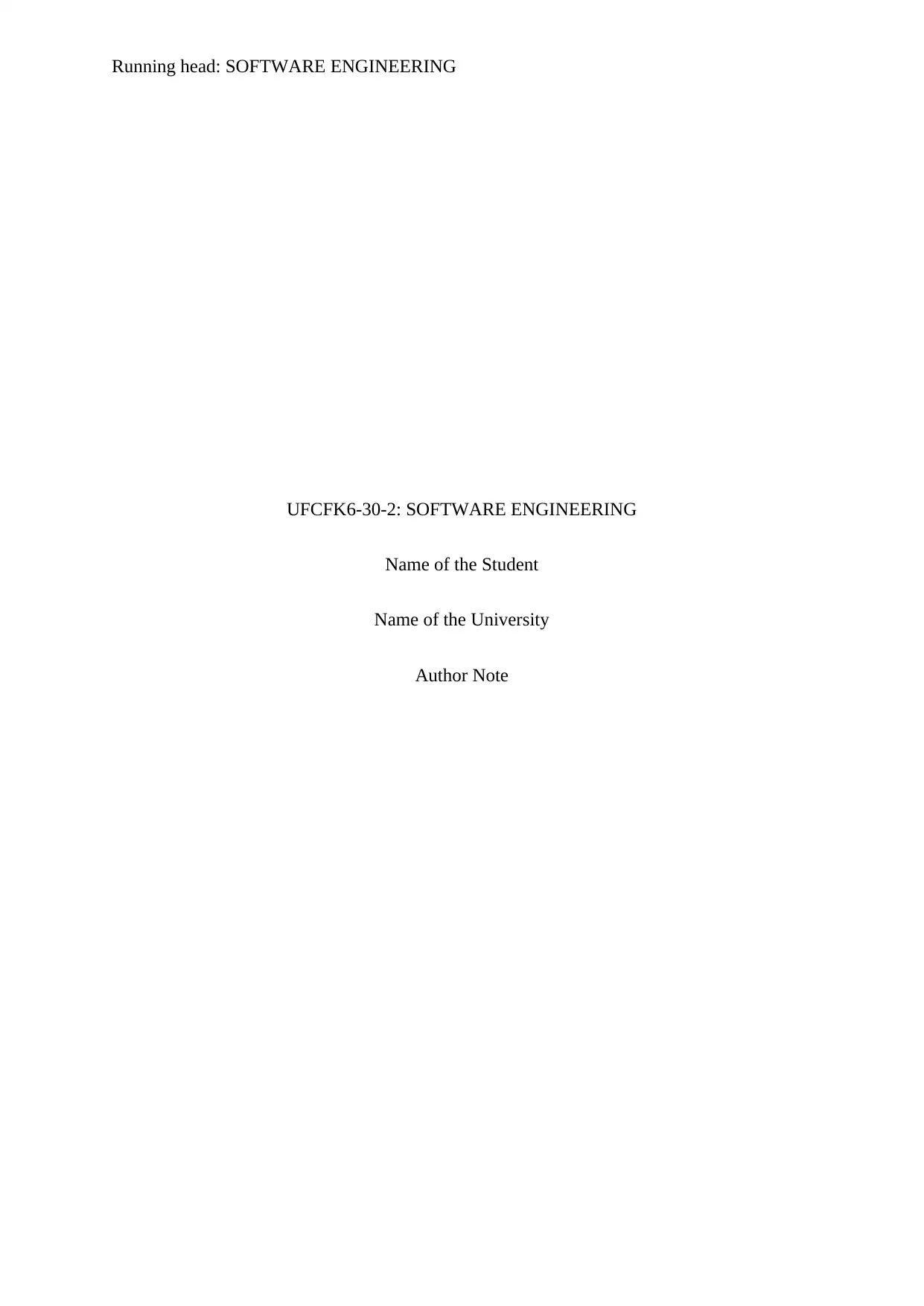
Running head: SOFTWARE ENGINEERING
UFCFK6-30-2: SOFTWARE ENGINEERING
Name of the Student
Name of the University
Author Note
UFCFK6-30-2: SOFTWARE ENGINEERING
Name of the Student
Name of the University
Author Note
Paraphrase This Document
Need a fresh take? Get an instant paraphrase of this document with our AI Paraphraser
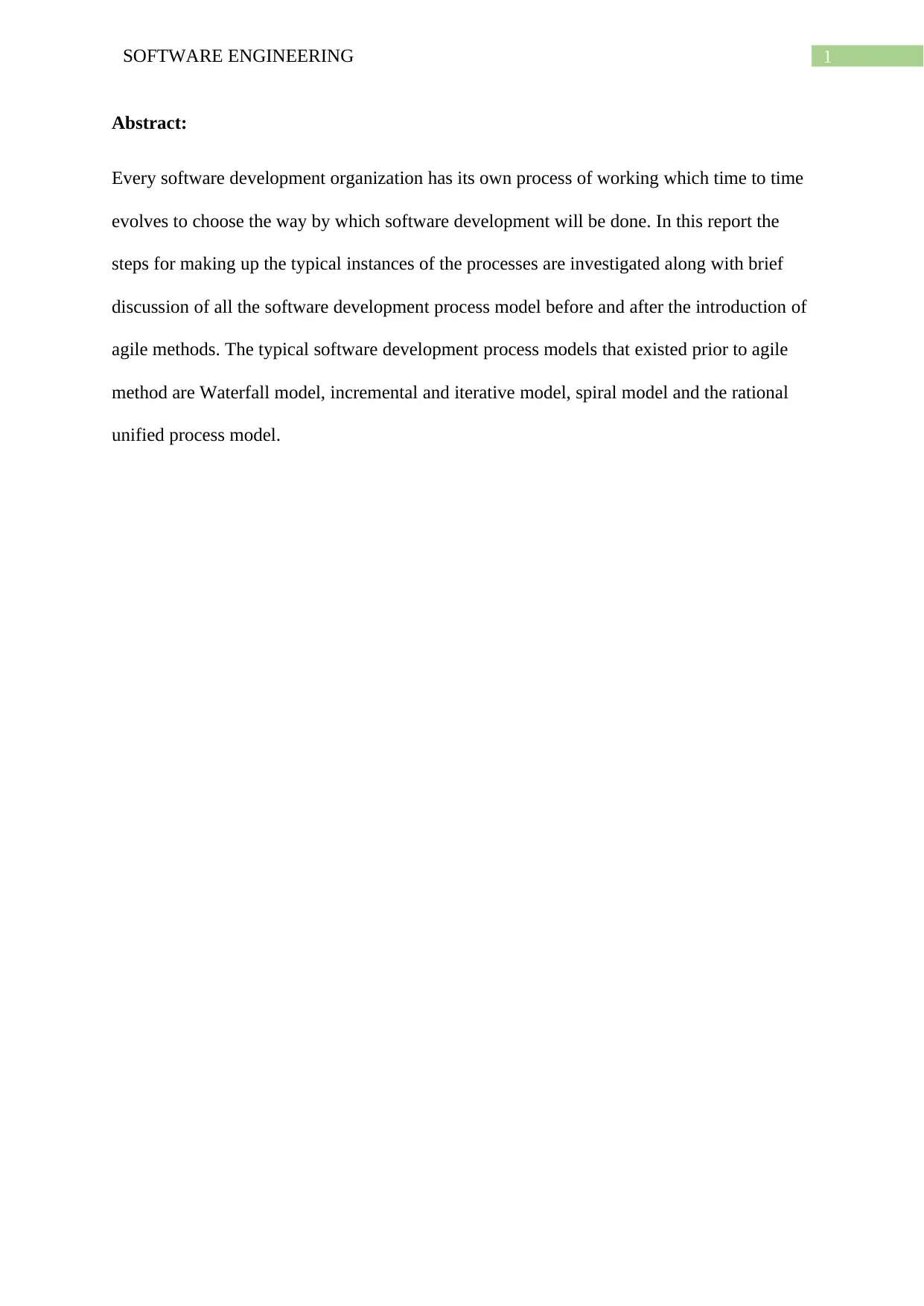
1SOFTWARE ENGINEERING
Abstract:
Every software development organization has its own process of working which time to time
evolves to choose the way by which software development will be done. In this report the
steps for making up the typical instances of the processes are investigated along with brief
discussion of all the software development process model before and after the introduction of
agile methods. The typical software development process models that existed prior to agile
method are Waterfall model, incremental and iterative model, spiral model and the rational
unified process model.
Abstract:
Every software development organization has its own process of working which time to time
evolves to choose the way by which software development will be done. In this report the
steps for making up the typical instances of the processes are investigated along with brief
discussion of all the software development process model before and after the introduction of
agile methods. The typical software development process models that existed prior to agile
method are Waterfall model, incremental and iterative model, spiral model and the rational
unified process model.
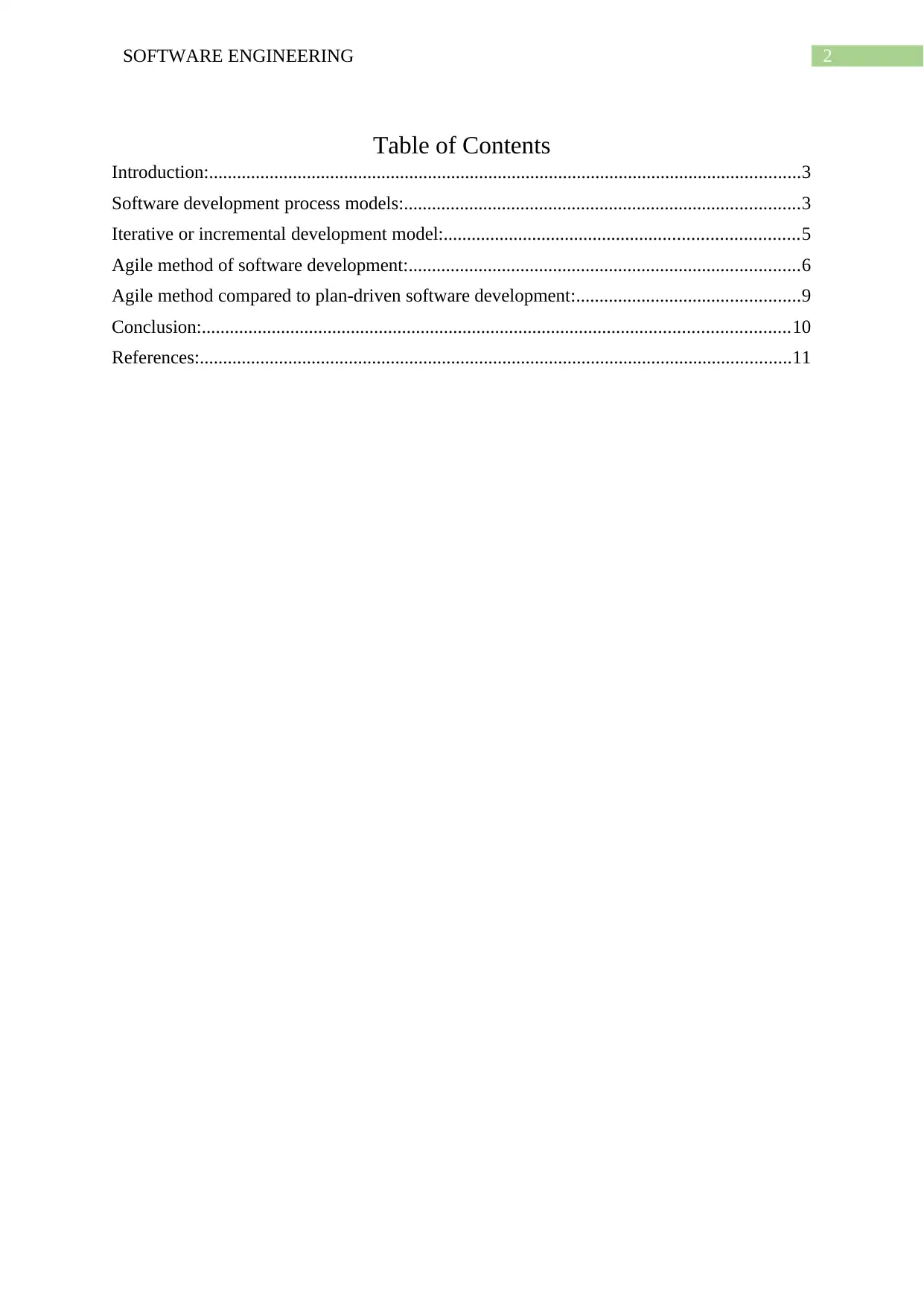
2SOFTWARE ENGINEERING
Table of Contents
Introduction:...............................................................................................................................3
Software development process models:.....................................................................................3
Iterative or incremental development model:............................................................................5
Agile method of software development:....................................................................................6
Agile method compared to plan-driven software development:................................................9
Conclusion:..............................................................................................................................10
References:...............................................................................................................................11
Table of Contents
Introduction:...............................................................................................................................3
Software development process models:.....................................................................................3
Iterative or incremental development model:............................................................................5
Agile method of software development:....................................................................................6
Agile method compared to plan-driven software development:................................................9
Conclusion:..............................................................................................................................10
References:...............................................................................................................................11
⊘ This is a preview!⊘
Do you want full access?
Subscribe today to unlock all pages.

Trusted by 1+ million students worldwide
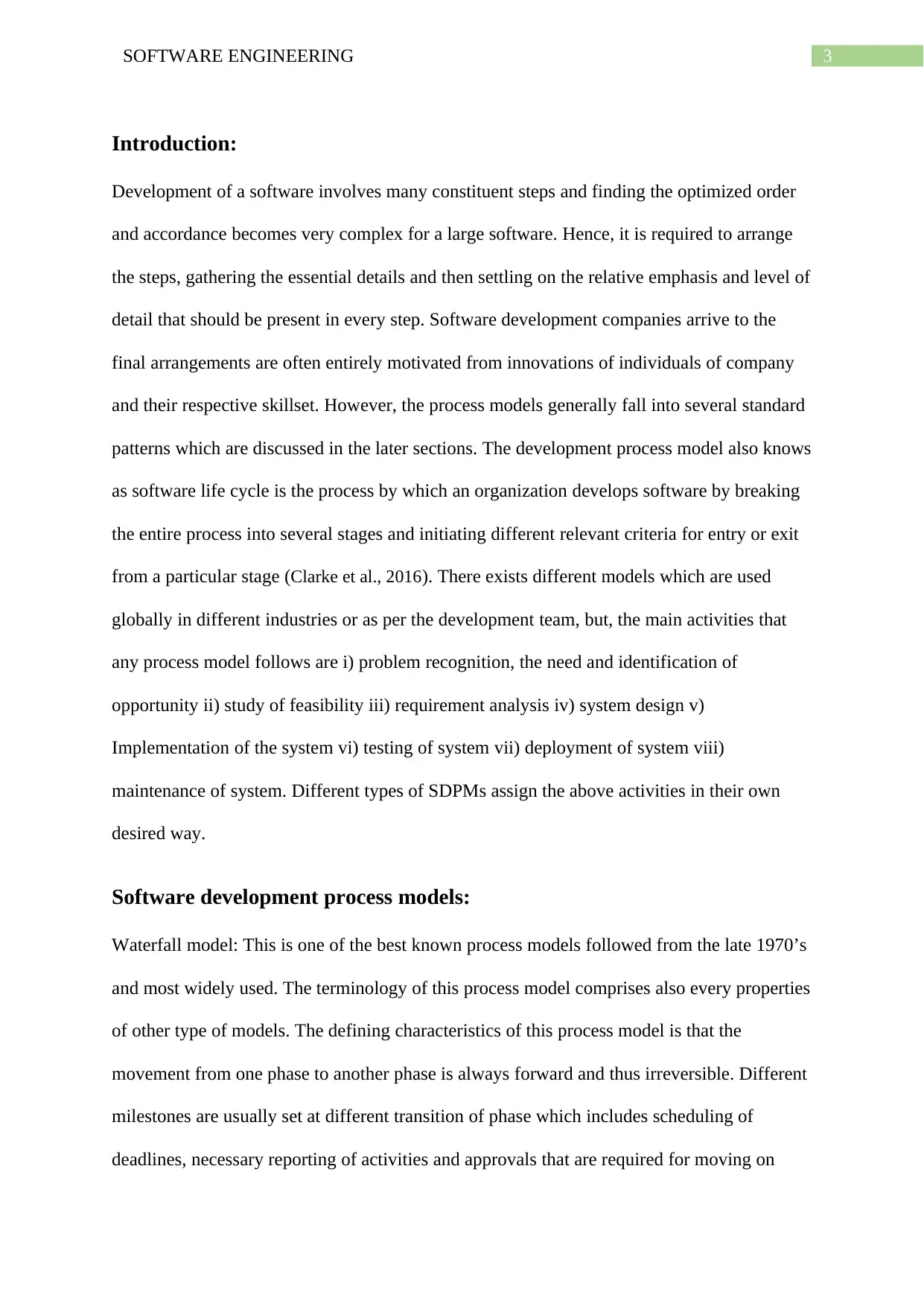
3SOFTWARE ENGINEERING
Introduction:
Development of a software involves many constituent steps and finding the optimized order
and accordance becomes very complex for a large software. Hence, it is required to arrange
the steps, gathering the essential details and then settling on the relative emphasis and level of
detail that should be present in every step. Software development companies arrive to the
final arrangements are often entirely motivated from innovations of individuals of company
and their respective skillset. However, the process models generally fall into several standard
patterns which are discussed in the later sections. The development process model also knows
as software life cycle is the process by which an organization develops software by breaking
the entire process into several stages and initiating different relevant criteria for entry or exit
from a particular stage (Clarke et al., 2016). There exists different models which are used
globally in different industries or as per the development team, but, the main activities that
any process model follows are i) problem recognition, the need and identification of
opportunity ii) study of feasibility iii) requirement analysis iv) system design v)
Implementation of the system vi) testing of system vii) deployment of system viii)
maintenance of system. Different types of SDPMs assign the above activities in their own
desired way.
Software development process models:
Waterfall model: This is one of the best known process models followed from the late 1970’s
and most widely used. The terminology of this process model comprises also every properties
of other type of models. The defining characteristics of this process model is that the
movement from one phase to another phase is always forward and thus irreversible. Different
milestones are usually set at different transition of phase which includes scheduling of
deadlines, necessary reporting of activities and approvals that are required for moving on
Introduction:
Development of a software involves many constituent steps and finding the optimized order
and accordance becomes very complex for a large software. Hence, it is required to arrange
the steps, gathering the essential details and then settling on the relative emphasis and level of
detail that should be present in every step. Software development companies arrive to the
final arrangements are often entirely motivated from innovations of individuals of company
and their respective skillset. However, the process models generally fall into several standard
patterns which are discussed in the later sections. The development process model also knows
as software life cycle is the process by which an organization develops software by breaking
the entire process into several stages and initiating different relevant criteria for entry or exit
from a particular stage (Clarke et al., 2016). There exists different models which are used
globally in different industries or as per the development team, but, the main activities that
any process model follows are i) problem recognition, the need and identification of
opportunity ii) study of feasibility iii) requirement analysis iv) system design v)
Implementation of the system vi) testing of system vii) deployment of system viii)
maintenance of system. Different types of SDPMs assign the above activities in their own
desired way.
Software development process models:
Waterfall model: This is one of the best known process models followed from the late 1970’s
and most widely used. The terminology of this process model comprises also every properties
of other type of models. The defining characteristics of this process model is that the
movement from one phase to another phase is always forward and thus irreversible. Different
milestones are usually set at different transition of phase which includes scheduling of
deadlines, necessary reporting of activities and approvals that are required for moving on
Paraphrase This Document
Need a fresh take? Get an instant paraphrase of this document with our AI Paraphraser
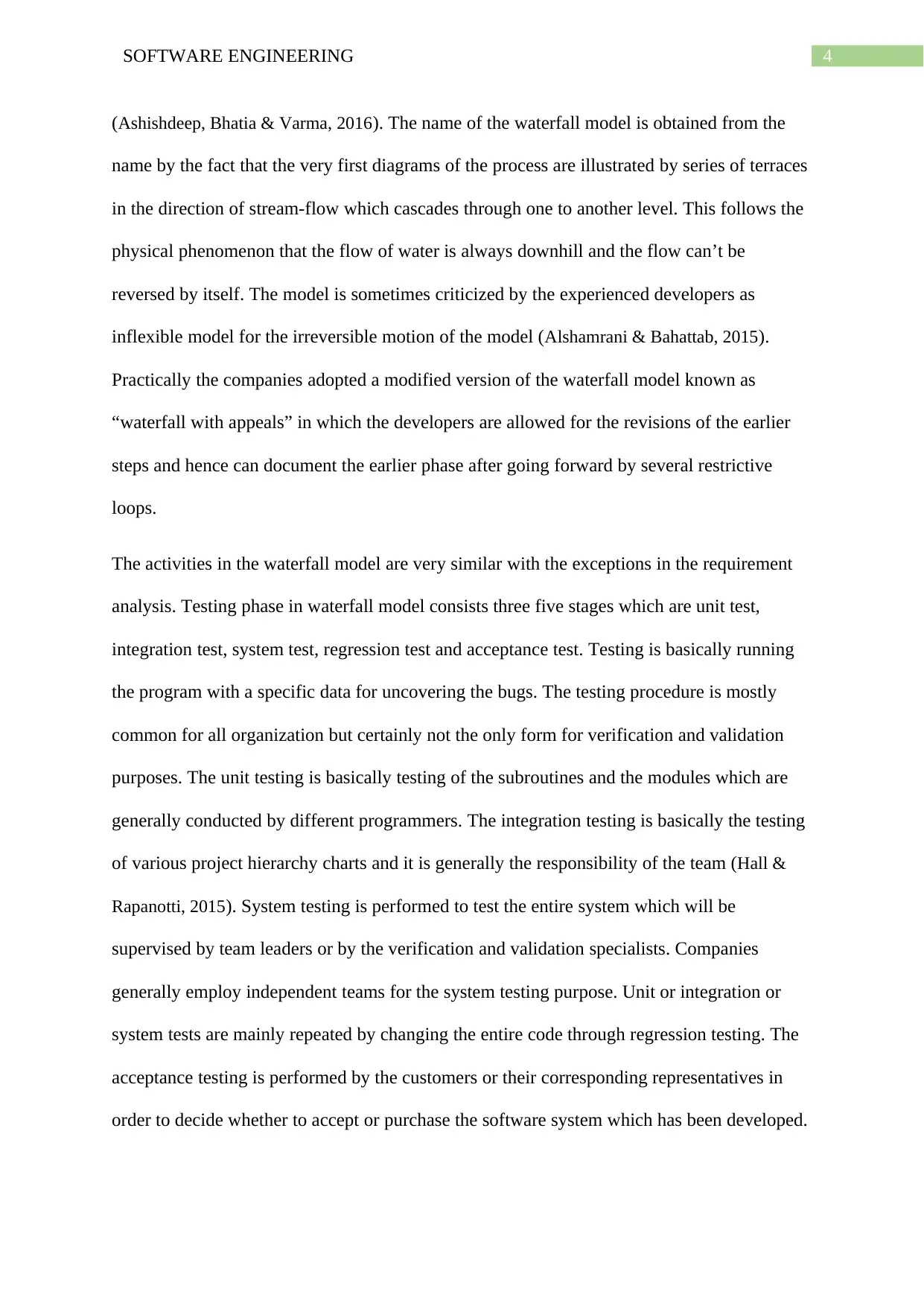
4SOFTWARE ENGINEERING
(Ashishdeep, Bhatia & Varma, 2016). The name of the waterfall model is obtained from the
name by the fact that the very first diagrams of the process are illustrated by series of terraces
in the direction of stream-flow which cascades through one to another level. This follows the
physical phenomenon that the flow of water is always downhill and the flow can’t be
reversed by itself. The model is sometimes criticized by the experienced developers as
inflexible model for the irreversible motion of the model (Alshamrani & Bahattab, 2015).
Practically the companies adopted a modified version of the waterfall model known as
“waterfall with appeals” in which the developers are allowed for the revisions of the earlier
steps and hence can document the earlier phase after going forward by several restrictive
loops.
The activities in the waterfall model are very similar with the exceptions in the requirement
analysis. Testing phase in waterfall model consists three five stages which are unit test,
integration test, system test, regression test and acceptance test. Testing is basically running
the program with a specific data for uncovering the bugs. The testing procedure is mostly
common for all organization but certainly not the only form for verification and validation
purposes. The unit testing is basically testing of the subroutines and the modules which are
generally conducted by different programmers. The integration testing is basically the testing
of various project hierarchy charts and it is generally the responsibility of the team (Hall &
Rapanotti, 2015). System testing is performed to test the entire system which will be
supervised by team leaders or by the verification and validation specialists. Companies
generally employ independent teams for the system testing purpose. Unit or integration or
system tests are mainly repeated by changing the entire code through regression testing. The
acceptance testing is performed by the customers or their corresponding representatives in
order to decide whether to accept or purchase the software system which has been developed.
(Ashishdeep, Bhatia & Varma, 2016). The name of the waterfall model is obtained from the
name by the fact that the very first diagrams of the process are illustrated by series of terraces
in the direction of stream-flow which cascades through one to another level. This follows the
physical phenomenon that the flow of water is always downhill and the flow can’t be
reversed by itself. The model is sometimes criticized by the experienced developers as
inflexible model for the irreversible motion of the model (Alshamrani & Bahattab, 2015).
Practically the companies adopted a modified version of the waterfall model known as
“waterfall with appeals” in which the developers are allowed for the revisions of the earlier
steps and hence can document the earlier phase after going forward by several restrictive
loops.
The activities in the waterfall model are very similar with the exceptions in the requirement
analysis. Testing phase in waterfall model consists three five stages which are unit test,
integration test, system test, regression test and acceptance test. Testing is basically running
the program with a specific data for uncovering the bugs. The testing procedure is mostly
common for all organization but certainly not the only form for verification and validation
purposes. The unit testing is basically testing of the subroutines and the modules which are
generally conducted by different programmers. The integration testing is basically the testing
of various project hierarchy charts and it is generally the responsibility of the team (Hall &
Rapanotti, 2015). System testing is performed to test the entire system which will be
supervised by team leaders or by the verification and validation specialists. Companies
generally employ independent teams for the system testing purpose. Unit or integration or
system tests are mainly repeated by changing the entire code through regression testing. The
acceptance testing is performed by the customers or their corresponding representatives in
order to decide whether to accept or purchase the software system which has been developed.
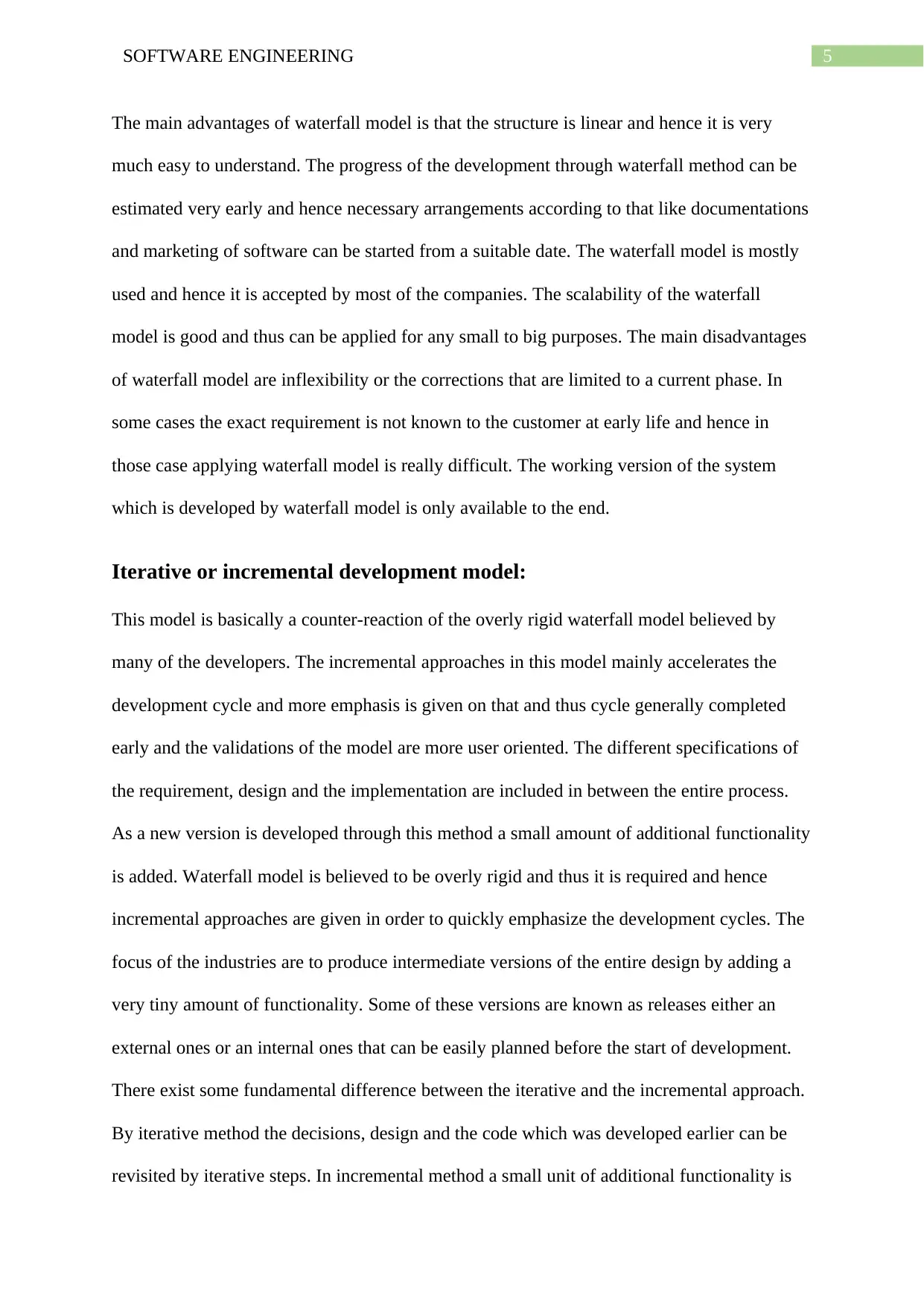
5SOFTWARE ENGINEERING
The main advantages of waterfall model is that the structure is linear and hence it is very
much easy to understand. The progress of the development through waterfall method can be
estimated very early and hence necessary arrangements according to that like documentations
and marketing of software can be started from a suitable date. The waterfall model is mostly
used and hence it is accepted by most of the companies. The scalability of the waterfall
model is good and thus can be applied for any small to big purposes. The main disadvantages
of waterfall model are inflexibility or the corrections that are limited to a current phase. In
some cases the exact requirement is not known to the customer at early life and hence in
those case applying waterfall model is really difficult. The working version of the system
which is developed by waterfall model is only available to the end.
Iterative or incremental development model:
This model is basically a counter-reaction of the overly rigid waterfall model believed by
many of the developers. The incremental approaches in this model mainly accelerates the
development cycle and more emphasis is given on that and thus cycle generally completed
early and the validations of the model are more user oriented. The different specifications of
the requirement, design and the implementation are included in between the entire process.
As a new version is developed through this method a small amount of additional functionality
is added. Waterfall model is believed to be overly rigid and thus it is required and hence
incremental approaches are given in order to quickly emphasize the development cycles. The
focus of the industries are to produce intermediate versions of the entire design by adding a
very tiny amount of functionality. Some of these versions are known as releases either an
external ones or an internal ones that can be easily planned before the start of development.
There exist some fundamental difference between the iterative and the incremental approach.
By iterative method the decisions, design and the code which was developed earlier can be
revisited by iterative steps. In incremental method a small unit of additional functionality is
The main advantages of waterfall model is that the structure is linear and hence it is very
much easy to understand. The progress of the development through waterfall method can be
estimated very early and hence necessary arrangements according to that like documentations
and marketing of software can be started from a suitable date. The waterfall model is mostly
used and hence it is accepted by most of the companies. The scalability of the waterfall
model is good and thus can be applied for any small to big purposes. The main disadvantages
of waterfall model are inflexibility or the corrections that are limited to a current phase. In
some cases the exact requirement is not known to the customer at early life and hence in
those case applying waterfall model is really difficult. The working version of the system
which is developed by waterfall model is only available to the end.
Iterative or incremental development model:
This model is basically a counter-reaction of the overly rigid waterfall model believed by
many of the developers. The incremental approaches in this model mainly accelerates the
development cycle and more emphasis is given on that and thus cycle generally completed
early and the validations of the model are more user oriented. The different specifications of
the requirement, design and the implementation are included in between the entire process.
As a new version is developed through this method a small amount of additional functionality
is added. Waterfall model is believed to be overly rigid and thus it is required and hence
incremental approaches are given in order to quickly emphasize the development cycles. The
focus of the industries are to produce intermediate versions of the entire design by adding a
very tiny amount of functionality. Some of these versions are known as releases either an
external ones or an internal ones that can be easily planned before the start of development.
There exist some fundamental difference between the iterative and the incremental approach.
By iterative method the decisions, design and the code which was developed earlier can be
revisited by iterative steps. In incremental method a small unit of additional functionality is
⊘ This is a preview!⊘
Do you want full access?
Subscribe today to unlock all pages.

Trusted by 1+ million students worldwide
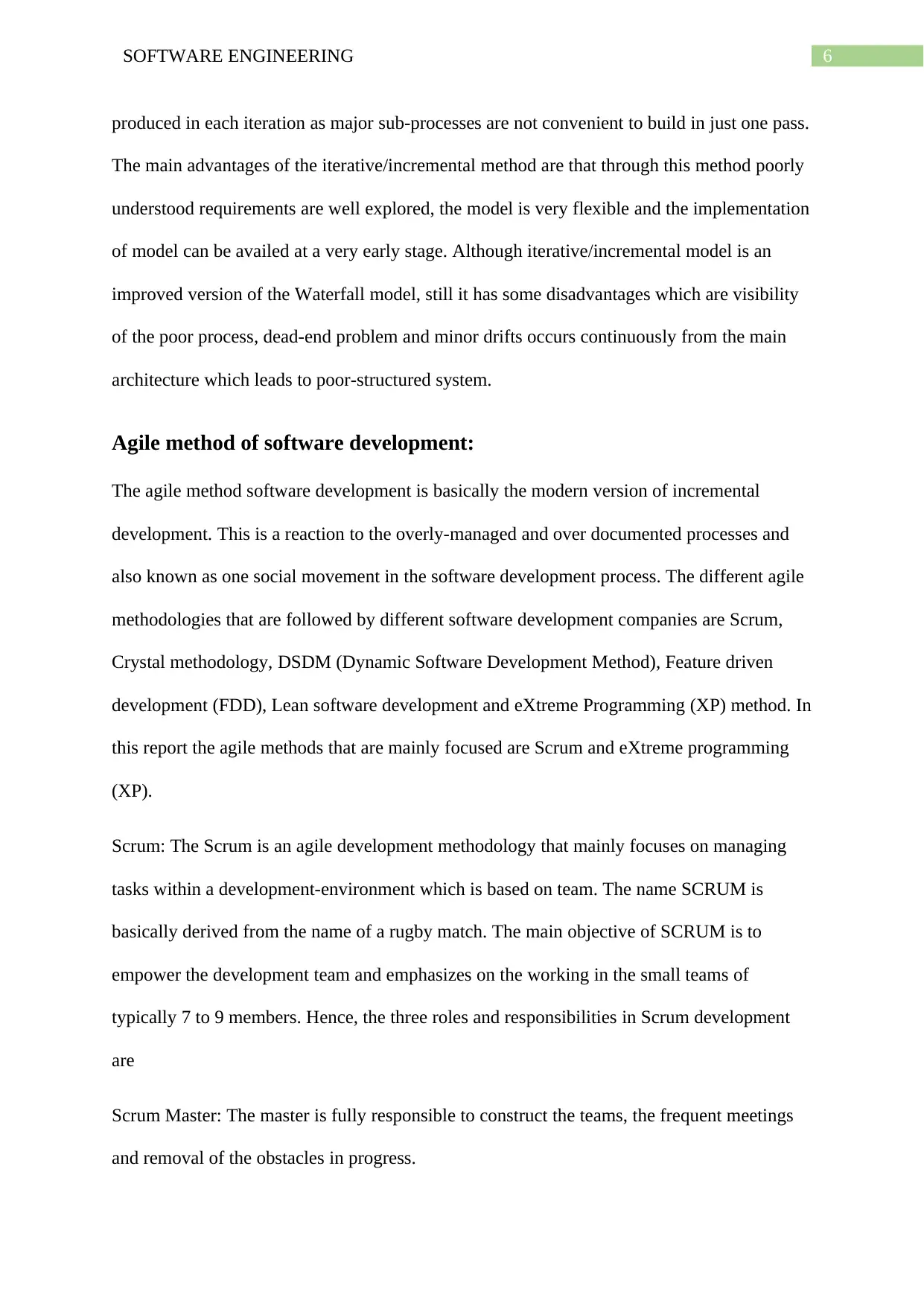
6SOFTWARE ENGINEERING
produced in each iteration as major sub-processes are not convenient to build in just one pass.
The main advantages of the iterative/incremental method are that through this method poorly
understood requirements are well explored, the model is very flexible and the implementation
of model can be availed at a very early stage. Although iterative/incremental model is an
improved version of the Waterfall model, still it has some disadvantages which are visibility
of the poor process, dead-end problem and minor drifts occurs continuously from the main
architecture which leads to poor-structured system.
Agile method of software development:
The agile method software development is basically the modern version of incremental
development. This is a reaction to the overly-managed and over documented processes and
also known as one social movement in the software development process. The different agile
methodologies that are followed by different software development companies are Scrum,
Crystal methodology, DSDM (Dynamic Software Development Method), Feature driven
development (FDD), Lean software development and eXtreme Programming (XP) method. In
this report the agile methods that are mainly focused are Scrum and eXtreme programming
(XP).
Scrum: The Scrum is an agile development methodology that mainly focuses on managing
tasks within a development-environment which is based on team. The name SCRUM is
basically derived from the name of a rugby match. The main objective of SCRUM is to
empower the development team and emphasizes on the working in the small teams of
typically 7 to 9 members. Hence, the three roles and responsibilities in Scrum development
are
Scrum Master: The master is fully responsible to construct the teams, the frequent meetings
and removal of the obstacles in progress.
produced in each iteration as major sub-processes are not convenient to build in just one pass.
The main advantages of the iterative/incremental method are that through this method poorly
understood requirements are well explored, the model is very flexible and the implementation
of model can be availed at a very early stage. Although iterative/incremental model is an
improved version of the Waterfall model, still it has some disadvantages which are visibility
of the poor process, dead-end problem and minor drifts occurs continuously from the main
architecture which leads to poor-structured system.
Agile method of software development:
The agile method software development is basically the modern version of incremental
development. This is a reaction to the overly-managed and over documented processes and
also known as one social movement in the software development process. The different agile
methodologies that are followed by different software development companies are Scrum,
Crystal methodology, DSDM (Dynamic Software Development Method), Feature driven
development (FDD), Lean software development and eXtreme Programming (XP) method. In
this report the agile methods that are mainly focused are Scrum and eXtreme programming
(XP).
Scrum: The Scrum is an agile development methodology that mainly focuses on managing
tasks within a development-environment which is based on team. The name SCRUM is
basically derived from the name of a rugby match. The main objective of SCRUM is to
empower the development team and emphasizes on the working in the small teams of
typically 7 to 9 members. Hence, the three roles and responsibilities in Scrum development
are
Scrum Master: The master is fully responsible to construct the teams, the frequent meetings
and removal of the obstacles in progress.
Paraphrase This Document
Need a fresh take? Get an instant paraphrase of this document with our AI Paraphraser
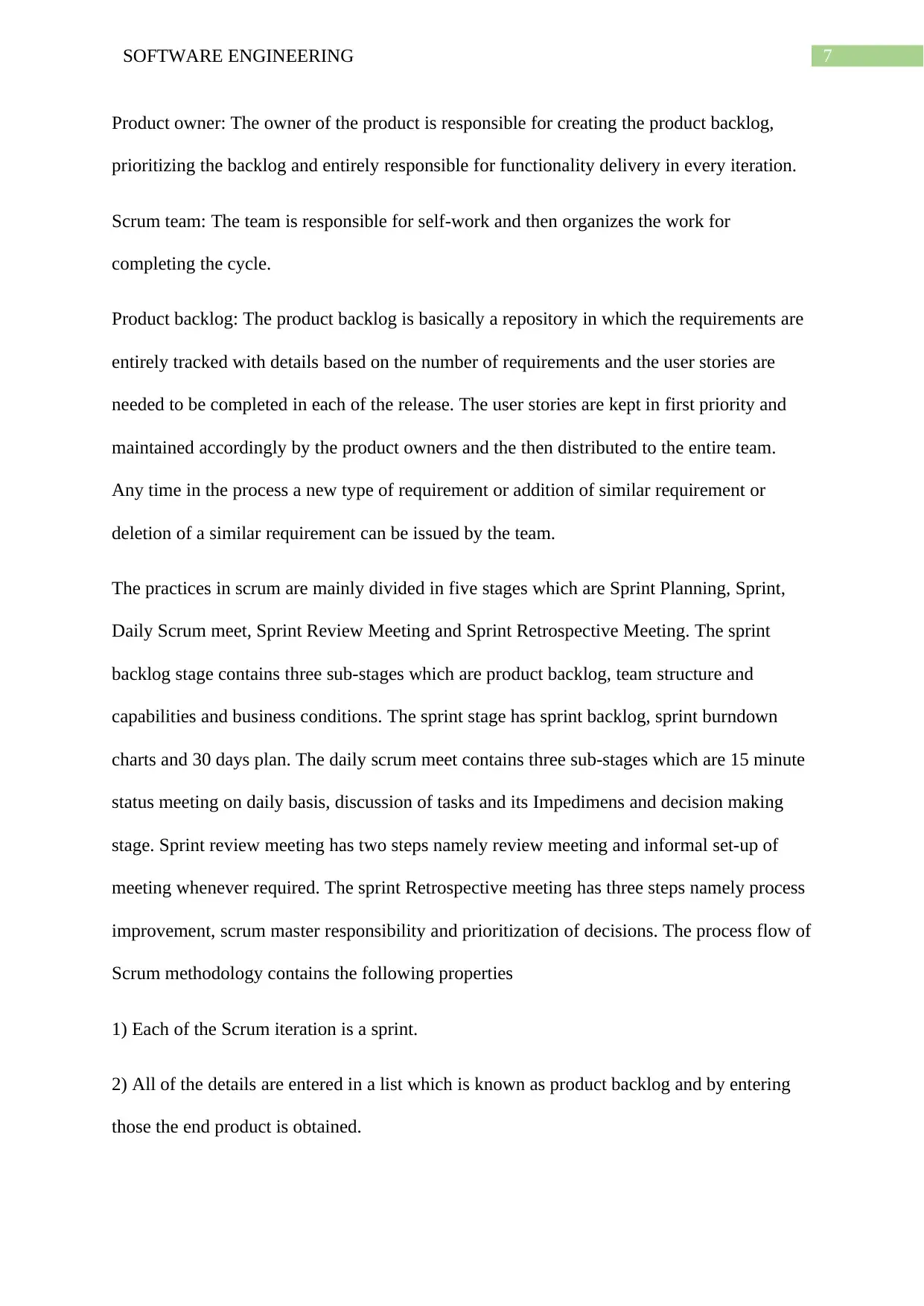
7SOFTWARE ENGINEERING
Product owner: The owner of the product is responsible for creating the product backlog,
prioritizing the backlog and entirely responsible for functionality delivery in every iteration.
Scrum team: The team is responsible for self-work and then organizes the work for
completing the cycle.
Product backlog: The product backlog is basically a repository in which the requirements are
entirely tracked with details based on the number of requirements and the user stories are
needed to be completed in each of the release. The user stories are kept in first priority and
maintained accordingly by the product owners and the then distributed to the entire team.
Any time in the process a new type of requirement or addition of similar requirement or
deletion of a similar requirement can be issued by the team.
The practices in scrum are mainly divided in five stages which are Sprint Planning, Sprint,
Daily Scrum meet, Sprint Review Meeting and Sprint Retrospective Meeting. The sprint
backlog stage contains three sub-stages which are product backlog, team structure and
capabilities and business conditions. The sprint stage has sprint backlog, sprint burndown
charts and 30 days plan. The daily scrum meet contains three sub-stages which are 15 minute
status meeting on daily basis, discussion of tasks and its Impedimens and decision making
stage. Sprint review meeting has two steps namely review meeting and informal set-up of
meeting whenever required. The sprint Retrospective meeting has three steps namely process
improvement, scrum master responsibility and prioritization of decisions. The process flow of
Scrum methodology contains the following properties
1) Each of the Scrum iteration is a sprint.
2) All of the details are entered in a list which is known as product backlog and by entering
those the end product is obtained.
Product owner: The owner of the product is responsible for creating the product backlog,
prioritizing the backlog and entirely responsible for functionality delivery in every iteration.
Scrum team: The team is responsible for self-work and then organizes the work for
completing the cycle.
Product backlog: The product backlog is basically a repository in which the requirements are
entirely tracked with details based on the number of requirements and the user stories are
needed to be completed in each of the release. The user stories are kept in first priority and
maintained accordingly by the product owners and the then distributed to the entire team.
Any time in the process a new type of requirement or addition of similar requirement or
deletion of a similar requirement can be issued by the team.
The practices in scrum are mainly divided in five stages which are Sprint Planning, Sprint,
Daily Scrum meet, Sprint Review Meeting and Sprint Retrospective Meeting. The sprint
backlog stage contains three sub-stages which are product backlog, team structure and
capabilities and business conditions. The sprint stage has sprint backlog, sprint burndown
charts and 30 days plan. The daily scrum meet contains three sub-stages which are 15 minute
status meeting on daily basis, discussion of tasks and its Impedimens and decision making
stage. Sprint review meeting has two steps namely review meeting and informal set-up of
meeting whenever required. The sprint Retrospective meeting has three steps namely process
improvement, scrum master responsibility and prioritization of decisions. The process flow of
Scrum methodology contains the following properties
1) Each of the Scrum iteration is a sprint.
2) All of the details are entered in a list which is known as product backlog and by entering
those the end product is obtained.
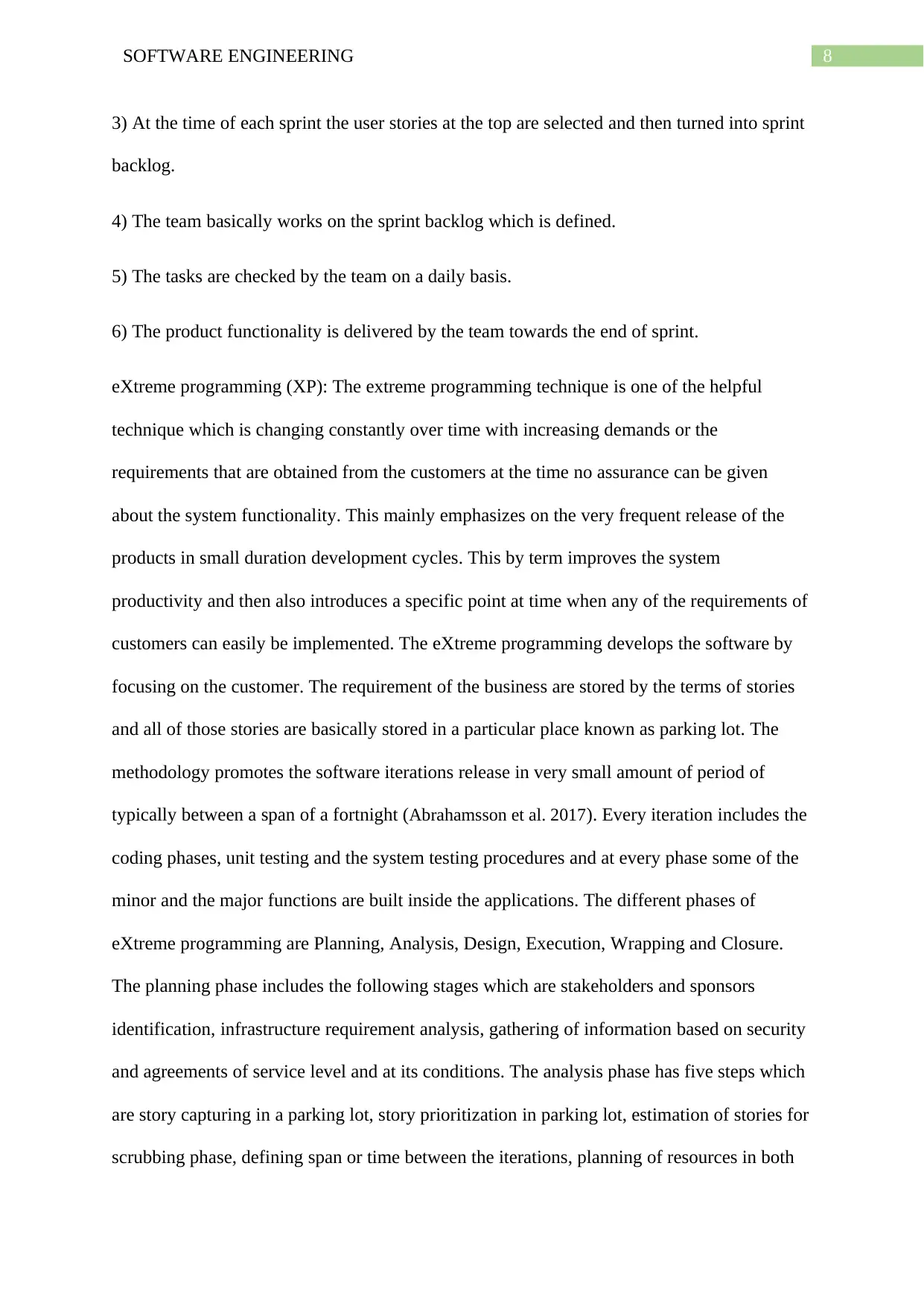
8SOFTWARE ENGINEERING
3) At the time of each sprint the user stories at the top are selected and then turned into sprint
backlog.
4) The team basically works on the sprint backlog which is defined.
5) The tasks are checked by the team on a daily basis.
6) The product functionality is delivered by the team towards the end of sprint.
eXtreme programming (XP): The extreme programming technique is one of the helpful
technique which is changing constantly over time with increasing demands or the
requirements that are obtained from the customers at the time no assurance can be given
about the system functionality. This mainly emphasizes on the very frequent release of the
products in small duration development cycles. This by term improves the system
productivity and then also introduces a specific point at time when any of the requirements of
customers can easily be implemented. The eXtreme programming develops the software by
focusing on the customer. The requirement of the business are stored by the terms of stories
and all of those stories are basically stored in a particular place known as parking lot. The
methodology promotes the software iterations release in very small amount of period of
typically between a span of a fortnight (Abrahamsson et al. 2017). Every iteration includes the
coding phases, unit testing and the system testing procedures and at every phase some of the
minor and the major functions are built inside the applications. The different phases of
eXtreme programming are Planning, Analysis, Design, Execution, Wrapping and Closure.
The planning phase includes the following stages which are stakeholders and sponsors
identification, infrastructure requirement analysis, gathering of information based on security
and agreements of service level and at its conditions. The analysis phase has five steps which
are story capturing in a parking lot, story prioritization in parking lot, estimation of stories for
scrubbing phase, defining span or time between the iterations, planning of resources in both
3) At the time of each sprint the user stories at the top are selected and then turned into sprint
backlog.
4) The team basically works on the sprint backlog which is defined.
5) The tasks are checked by the team on a daily basis.
6) The product functionality is delivered by the team towards the end of sprint.
eXtreme programming (XP): The extreme programming technique is one of the helpful
technique which is changing constantly over time with increasing demands or the
requirements that are obtained from the customers at the time no assurance can be given
about the system functionality. This mainly emphasizes on the very frequent release of the
products in small duration development cycles. This by term improves the system
productivity and then also introduces a specific point at time when any of the requirements of
customers can easily be implemented. The eXtreme programming develops the software by
focusing on the customer. The requirement of the business are stored by the terms of stories
and all of those stories are basically stored in a particular place known as parking lot. The
methodology promotes the software iterations release in very small amount of period of
typically between a span of a fortnight (Abrahamsson et al. 2017). Every iteration includes the
coding phases, unit testing and the system testing procedures and at every phase some of the
minor and the major functions are built inside the applications. The different phases of
eXtreme programming are Planning, Analysis, Design, Execution, Wrapping and Closure.
The planning phase includes the following stages which are stakeholders and sponsors
identification, infrastructure requirement analysis, gathering of information based on security
and agreements of service level and at its conditions. The analysis phase has five steps which
are story capturing in a parking lot, story prioritization in parking lot, estimation of stories for
scrubbing phase, defining span or time between the iterations, planning of resources in both
⊘ This is a preview!⊘
Do you want full access?
Subscribe today to unlock all pages.

Trusted by 1+ million students worldwide
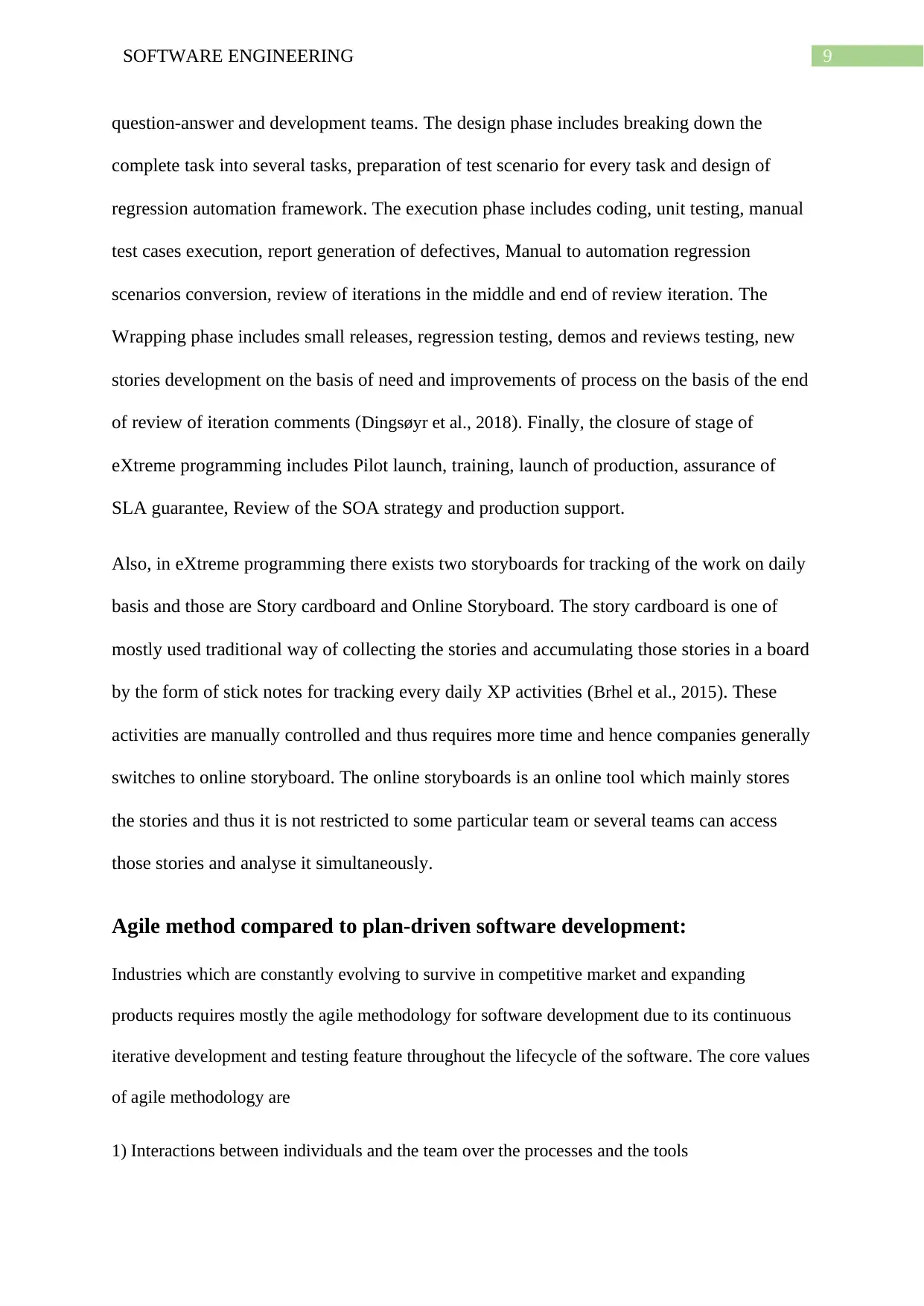
9SOFTWARE ENGINEERING
question-answer and development teams. The design phase includes breaking down the
complete task into several tasks, preparation of test scenario for every task and design of
regression automation framework. The execution phase includes coding, unit testing, manual
test cases execution, report generation of defectives, Manual to automation regression
scenarios conversion, review of iterations in the middle and end of review iteration. The
Wrapping phase includes small releases, regression testing, demos and reviews testing, new
stories development on the basis of need and improvements of process on the basis of the end
of review of iteration comments (Dingsøyr et al., 2018). Finally, the closure of stage of
eXtreme programming includes Pilot launch, training, launch of production, assurance of
SLA guarantee, Review of the SOA strategy and production support.
Also, in eXtreme programming there exists two storyboards for tracking of the work on daily
basis and those are Story cardboard and Online Storyboard. The story cardboard is one of
mostly used traditional way of collecting the stories and accumulating those stories in a board
by the form of stick notes for tracking every daily XP activities (Brhel et al., 2015). These
activities are manually controlled and thus requires more time and hence companies generally
switches to online storyboard. The online storyboards is an online tool which mainly stores
the stories and thus it is not restricted to some particular team or several teams can access
those stories and analyse it simultaneously.
Agile method compared to plan-driven software development:
Industries which are constantly evolving to survive in competitive market and expanding
products requires mostly the agile methodology for software development due to its continuous
iterative development and testing feature throughout the lifecycle of the software. The core values
of agile methodology are
1) Interactions between individuals and the team over the processes and the tools
question-answer and development teams. The design phase includes breaking down the
complete task into several tasks, preparation of test scenario for every task and design of
regression automation framework. The execution phase includes coding, unit testing, manual
test cases execution, report generation of defectives, Manual to automation regression
scenarios conversion, review of iterations in the middle and end of review iteration. The
Wrapping phase includes small releases, regression testing, demos and reviews testing, new
stories development on the basis of need and improvements of process on the basis of the end
of review of iteration comments (Dingsøyr et al., 2018). Finally, the closure of stage of
eXtreme programming includes Pilot launch, training, launch of production, assurance of
SLA guarantee, Review of the SOA strategy and production support.
Also, in eXtreme programming there exists two storyboards for tracking of the work on daily
basis and those are Story cardboard and Online Storyboard. The story cardboard is one of
mostly used traditional way of collecting the stories and accumulating those stories in a board
by the form of stick notes for tracking every daily XP activities (Brhel et al., 2015). These
activities are manually controlled and thus requires more time and hence companies generally
switches to online storyboard. The online storyboards is an online tool which mainly stores
the stories and thus it is not restricted to some particular team or several teams can access
those stories and analyse it simultaneously.
Agile method compared to plan-driven software development:
Industries which are constantly evolving to survive in competitive market and expanding
products requires mostly the agile methodology for software development due to its continuous
iterative development and testing feature throughout the lifecycle of the software. The core values
of agile methodology are
1) Interactions between individuals and the team over the processes and the tools
Paraphrase This Document
Need a fresh take? Get an instant paraphrase of this document with our AI Paraphraser
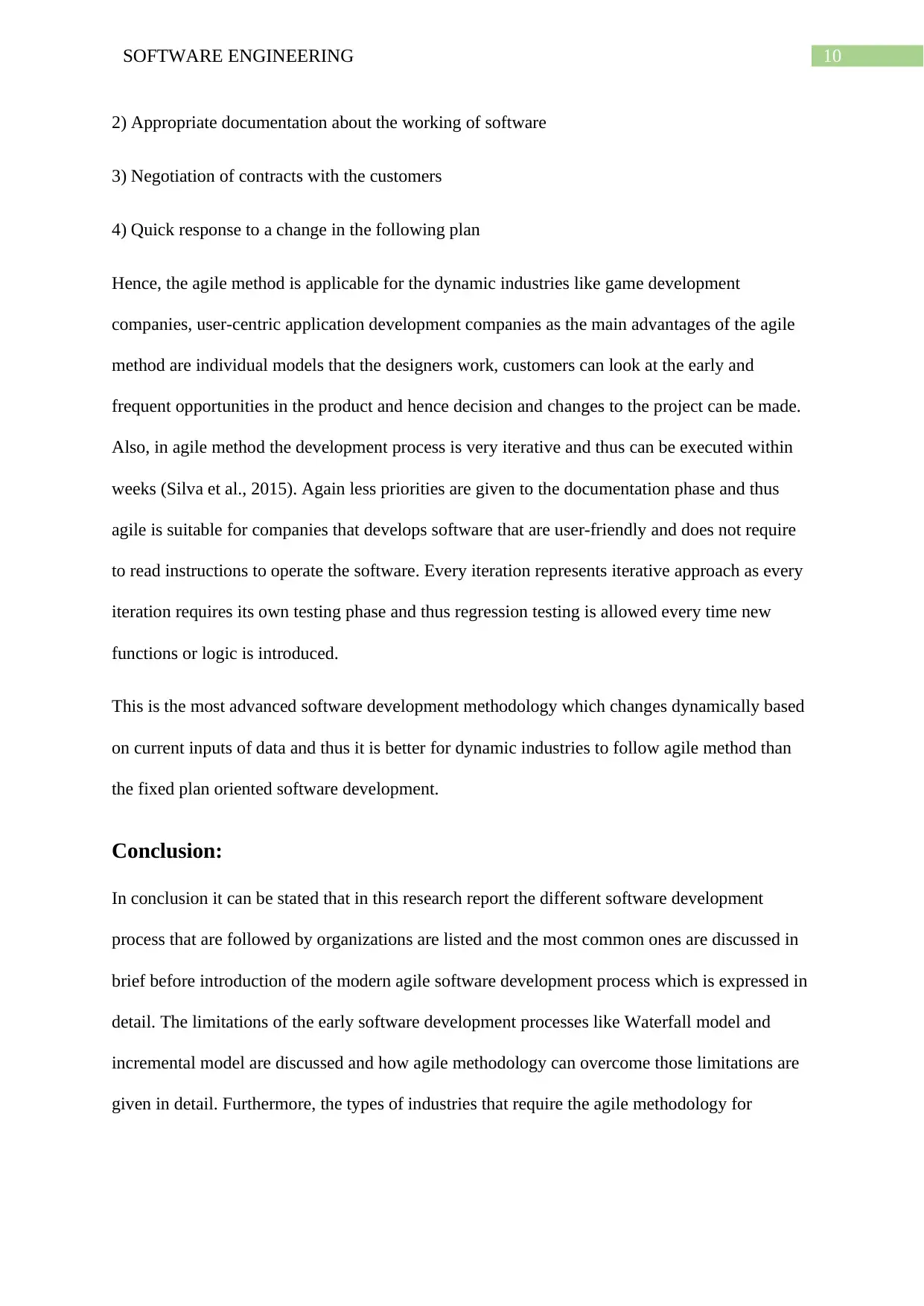
10SOFTWARE ENGINEERING
2) Appropriate documentation about the working of software
3) Negotiation of contracts with the customers
4) Quick response to a change in the following plan
Hence, the agile method is applicable for the dynamic industries like game development
companies, user-centric application development companies as the main advantages of the agile
method are individual models that the designers work, customers can look at the early and
frequent opportunities in the product and hence decision and changes to the project can be made.
Also, in agile method the development process is very iterative and thus can be executed within
weeks (Silva et al., 2015). Again less priorities are given to the documentation phase and thus
agile is suitable for companies that develops software that are user-friendly and does not require
to read instructions to operate the software. Every iteration represents iterative approach as every
iteration requires its own testing phase and thus regression testing is allowed every time new
functions or logic is introduced.
This is the most advanced software development methodology which changes dynamically based
on current inputs of data and thus it is better for dynamic industries to follow agile method than
the fixed plan oriented software development.
Conclusion:
In conclusion it can be stated that in this research report the different software development
process that are followed by organizations are listed and the most common ones are discussed in
brief before introduction of the modern agile software development process which is expressed in
detail. The limitations of the early software development processes like Waterfall model and
incremental model are discussed and how agile methodology can overcome those limitations are
given in detail. Furthermore, the types of industries that require the agile methodology for
2) Appropriate documentation about the working of software
3) Negotiation of contracts with the customers
4) Quick response to a change in the following plan
Hence, the agile method is applicable for the dynamic industries like game development
companies, user-centric application development companies as the main advantages of the agile
method are individual models that the designers work, customers can look at the early and
frequent opportunities in the product and hence decision and changes to the project can be made.
Also, in agile method the development process is very iterative and thus can be executed within
weeks (Silva et al., 2015). Again less priorities are given to the documentation phase and thus
agile is suitable for companies that develops software that are user-friendly and does not require
to read instructions to operate the software. Every iteration represents iterative approach as every
iteration requires its own testing phase and thus regression testing is allowed every time new
functions or logic is introduced.
This is the most advanced software development methodology which changes dynamically based
on current inputs of data and thus it is better for dynamic industries to follow agile method than
the fixed plan oriented software development.
Conclusion:
In conclusion it can be stated that in this research report the different software development
process that are followed by organizations are listed and the most common ones are discussed in
brief before introduction of the modern agile software development process which is expressed in
detail. The limitations of the early software development processes like Waterfall model and
incremental model are discussed and how agile methodology can overcome those limitations are
given in detail. Furthermore, the types of industries that require the agile methodology for
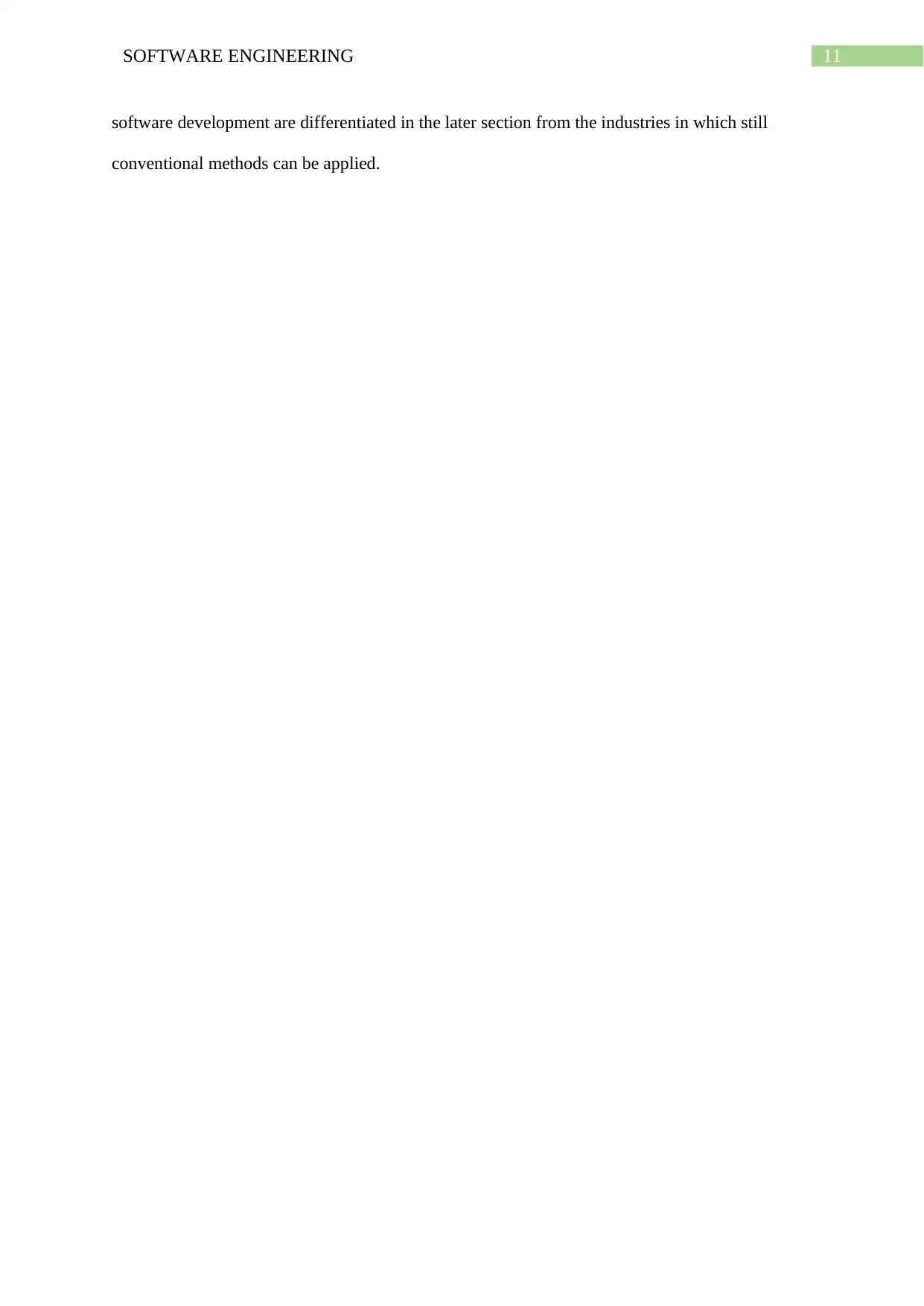
11SOFTWARE ENGINEERING
software development are differentiated in the later section from the industries in which still
conventional methods can be applied.
software development are differentiated in the later section from the industries in which still
conventional methods can be applied.
⊘ This is a preview!⊘
Do you want full access?
Subscribe today to unlock all pages.

Trusted by 1+ million students worldwide
1 out of 14
Related Documents
Your All-in-One AI-Powered Toolkit for Academic Success.
+13062052269
info@desklib.com
Available 24*7 on WhatsApp / Email
![[object Object]](/_next/static/media/star-bottom.7253800d.svg)
Unlock your academic potential
Copyright © 2020–2025 A2Z Services. All Rights Reserved. Developed and managed by ZUCOL.



